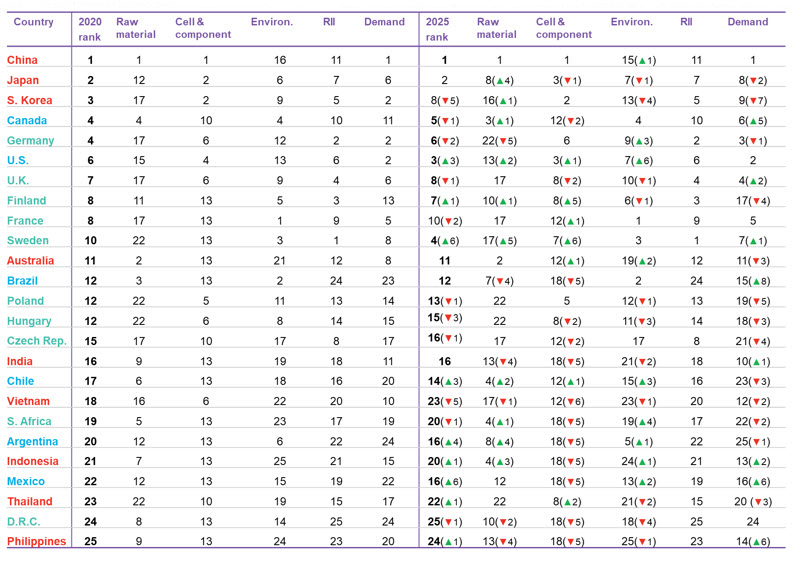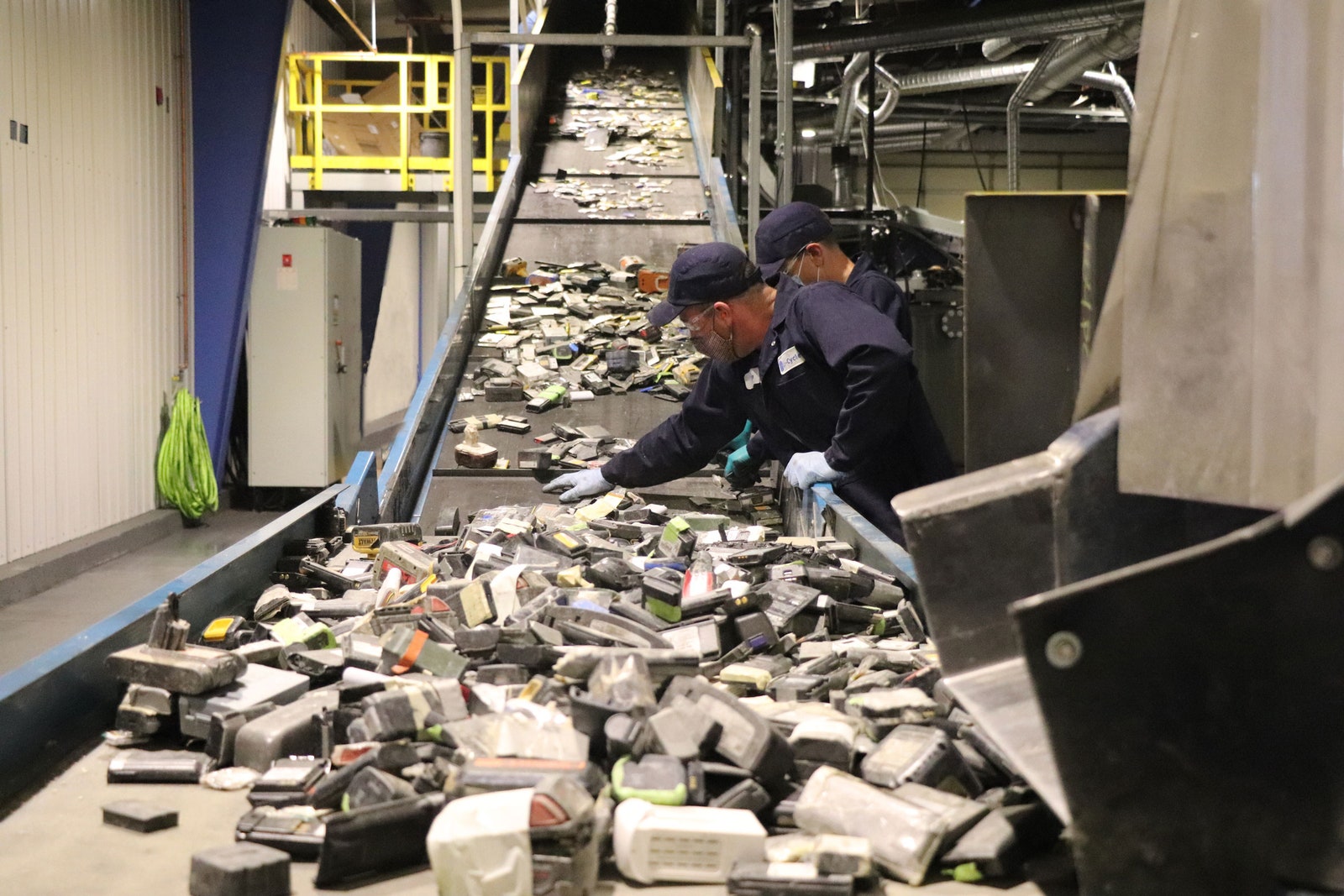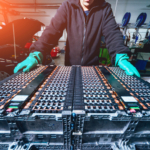Battery Life Phases
Ever wonder where the raw materials in your car battery actually come from, and what happens when the battery no longer meets capacity requirements to power your vehicle? The life cycle of electric vehicle batteries are complex, and they span numerous countries around the globe before finally “retiring” to less intensive jobs, or even being recycled into completely new cells. An EV battery goes through four life phases in its cycle: development, vehicle use, second life and recycling.
Development
Cell chemistry is a recipe, and the ingredients of the cake (the lithium-ion battery cell) comprise four components: cathode, anode, separator and battery electrolyte. The cathode, or positive pole, is currently made from a combination of materials that commonly include lithium, nickel, manganese, cobalt and aluminum. The anode, or negative pole, is usually made from graphite. These resources are scattered on nearly every continent around the globe, including low precipitation regions in developing countries.
The graphic below illustrates the main lithium production, reserves and resource locations from 2016. Mining in many of these arid regions fuels conflict between environmentalists, local populations and mine operators due to the large water requirements when extracting lithium. Regardless, companies must ask themselves how responsible and sustainable their resource supply chains are. This ongoing conflict is something that will need to be solved if our society is to successfully transfer to a fully electric future that does not rely on fossil fuels. Recently, major car manufacturer BMW has restructured its resource extraction processes to give top priority to ethical sourcing of materials with regards to human rights and evioronmental standards. LION Smart’s longstanding partnership with BMW ensures the batteries supplied to our customers are sourced as sustainably as possible through BMW supply chains.
Main lithium primary production, reserves and resources in 2016. Despite a global reserve of 94 million tons, technical and environmental mining challenges keep this resource in low supply. Source: USGS, European Comission.
Currently, over 80% of raw material refining and 60% of the world’s battery cell component manufacturing happens in China. Japan and Korea are also major players in battery cell manufacturing, however future forecasts show North America and Europe will be investing heavily in these areas over the next 5-10 years. In Germany, where LION Smart operates, the government is ramping up domestic battery production and research with more than EUR 1.5 billion in subsidies and investments.
The vast majority of raw material mining and component manufacturing currently happens in Asia. Source: BloombergNEF
Vehicle Usage
The best range for new electric vehicles is already over 600 km on a single charge, and that range continues to increase as battery technology becomes more and more efficient. The lifespan of a car battery depends to a large extent on the usage and behavior of the driver. For example, using a fast car battery charger stresses batteries more than a conventional car charger, and reduces overall charging capacity much sooner over the long-term. Additionally, the number of charging cycles, degree of discharge, ambient temperature, and the age of the battery are all important factors that can influence battery life.
Second Life
An EV battery no longer meets the requirements for driving once energy capacity has been reduced to 70 – 80%. However, this doesn’t mean they no longer serve a purpose. After use in electric vehicles, many battery modules get a second chance in terms of consumer power grids – a new purpose as stationary energy storage devices. The cumulative power from these cells is available within seconds and keeps the energy grid stable. During the day (and night), the amount of electricity fed into the grid is based on the estimated demand of all consumers. This involves forecasting every 15 minutes and determining which power generation plants can meet the demand. Most often, generation from wind and solar power is prioritized, but this is weather-dependent and therefore not 100% predictable. If there is too much electricity in the grid due to fluctuations in production or demand, batteries store the excess. If there is a shortage of electricity, then batteries supply it. Old electric vehicle batteries could operate for a decade or more in this less demanding role, and there is a growing number of companies investing in research related to conversion of EV batteries into stationary storage applications.
Recycling
By 2030, used lithium-ion batteries are expected to reach a staggering 200 million metric tons per year. Currently, most battery packs end up in a landfill, but they contain valuable metals that can be recovered and reused in the manufacturing of new cells. The recycling rates in the EU and USA are only around 5%, and this number needs to increase dramatically if society is to meet the looming raw material shortage for cell production. Battery recycling holds the potential for even greater cost efficiency than mining if the technology to do so can be optimized.
There appear to be several processes for recycling lithium-ion batteries – which are most relevant for car batteries and why?
Recycling processes for lithium-ion batteries can be divided into three primary types: pyrometallurgical, hydrometallurgy and mechanical crushing. Pyrometallurgy, the most common process, involves burning the batteries to remove plastics and organic materials, but leaves just a fraction of the original material. Hydrometallurgy requires soaking lithium-ion cells in strong acids to dissolve the metals into a solution, which can be extracted afterwards. The newest processes that utilize mechanical crushing are based almost exclusively on shredding and material separation because they are considerably cheaper to set up, much less energy intensive, and offer higher recycling efficiencies. In a milling machine, battery cells are taken apart by hand, except for their small components, as raw material. Next, the aluminum, electrode material and separator membrane are ground into tiny fragments in a special shredder. The shredder is powered by electricity discharged from the battery and can shred up to 500 kg of material per hour.
Are there differences in recycling automotive batteries and smartphone batteries?
The recycling of lithium-ion batteries is the same whether it is for portable applications or automotive applications. At their most basic level, automotive batteries are made up of smaller cells. These can be cylindrical (the same format as the cells in laptops), pouch-like or prismatic. The cells are grouped into modules and the modules are combined into a battery pack. The cells and modules are grouped in series and/or parallel to increase the current and voltage so that more power can be drawn from the battery. When recycling automotive batteries, the packs are discharged and broken down into modules or cells before being processed.
At BMW, a long time partner of LION Smart, a lab worker mixes electrode paste in the research center located in Munich. Source: BMW
Could changes in the chemistry of lithium-ion batteries in the future significantly impact their recyclability?
A number of different research projects are under development, such as solid-state lithium-ion batteries, sodium-ion batteries, or slightly changing the composition of existing chemistries using a smaller amount of one metal and more of another (e.g., replacing cobalt with nickel or manganese). In all cases, the most important factor determining recyclability is the value of the metals that go into the batteries. Ironically, the move toward batteries with cheaper metals will make them less recyclable because the labor required to do so will cost more than the value of the metal itself. In some cases, such as solid-state lithium-ion batteries, recycler profitability could increase because the batteries are much safer to process and therefore cheaper to recycle without the flammable electrolyte.
Authors:
Anna Kilischekow
Wade Million








